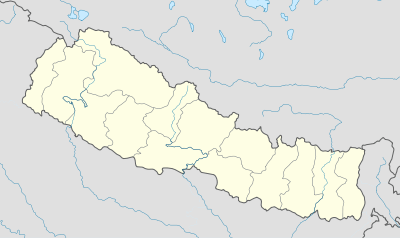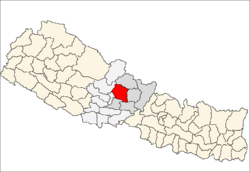Lahachok
| Lahachowk लाहाचोक | |
|---|---|
| Village Development Committee | |
 Lahachowk Location in Nepal | |
| Coordinates: 28°19′N 83°55′E / 28.31°N 83.92°ECoordinates: 28°19′N 83°55′E / 28.31°N 83.92°E | |
| Country | Nepal |
| Zone | Gandaki Zone |
| District | Kaski District |
| Population (1991) | |
| • Total | 3,188 |
| Time zone | Nepal Time (UTC+5:45) |
Lahachowk ( Nepali : लाहाचोक ) is a town and Village Development Committee in Kaski District in the Gandaki Zone of northern-central Nepal. According to National Population and Housing Census, 2011, it had a population of 3,129 persons living in 829 individual households.[1]
Lahachowk VDC is nestled in the lap of Machhapuchhre, a Himalaya of Annapurna Range. The village is situated at the height of 1200 meters from the sea level. Situated in North-west of Pokhara at a distance of around 13 kilometer, this village is composed of ethnic diversity and cultural variations. Major ethnic groups in the village are Brahmin, Chhetri, Dalits and indigenous groups like Gurung, Newar and Magars. The society is largely based on caste structure. Higher castes like Brahmin, Chhetri have higher access and control over resources and means of production. The people of higher caste have higher educational status. The Hindu religion predominates the others which is followed by Buddhism and few Christians. The society in Lahachowk is patriarchal one. The major occupation in the village is agriculture. Some of the people are involved in service sector and business sector. People go abroad for earning as well.
Literacy rate
The number of educated people is very less with a meager rate of 30% who all are youth and wishes to study and survive well, by getting jobs in or outside Nepal. The rest of the 60% population is only capable of doing counting for the business purpose and signing their names for the official purpose. The rest of the population is illiterate where education seems to be not a very necessary part of their work as some are young while some are so old that they don’t need to study at all.
Diversity of classes
Looking at the ethnic structure of the society Brahmin occupies the largest share of 43 percent. The population of Dalits is 28 percent Thakuri and Chhetri comprise 14 percent, while others which include some indigenous groups and some minorities comprise 15 percent.
Occupation
However the occupation is mostly on the basis of agriculture, which is around 46.7%, then is the labourers group going up to 30.9%, making the two most major jobs of the district. Very few of them are working abroad which is around 5.3% and government jobs are less with a rate of 4.9%, while the other different jobs have more people in the basket which is around 11.5% while business is just 0.7% which is equal to negligible.
References
- ↑ "Nepal Census 2001". Nepal's Village Development Committees. Digital Himalaya. Retrieved 30 September 2008.
National Population and Housing Census, 2011

